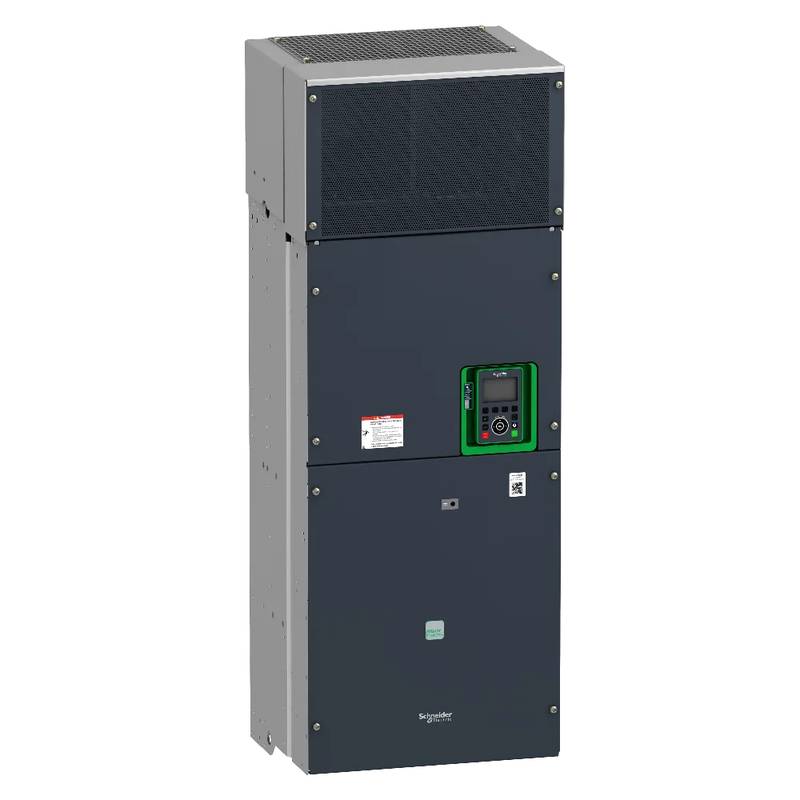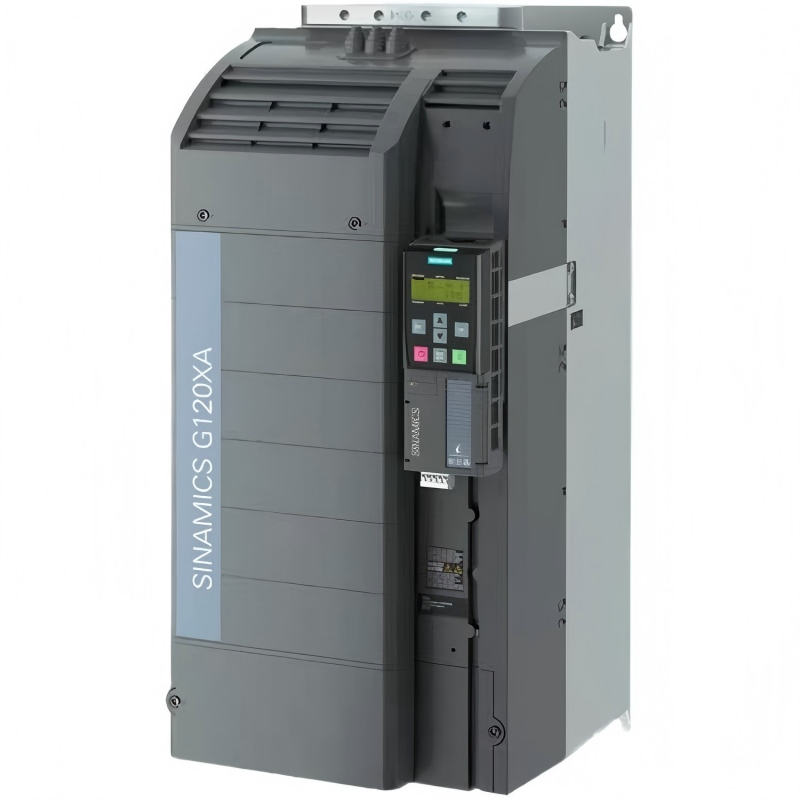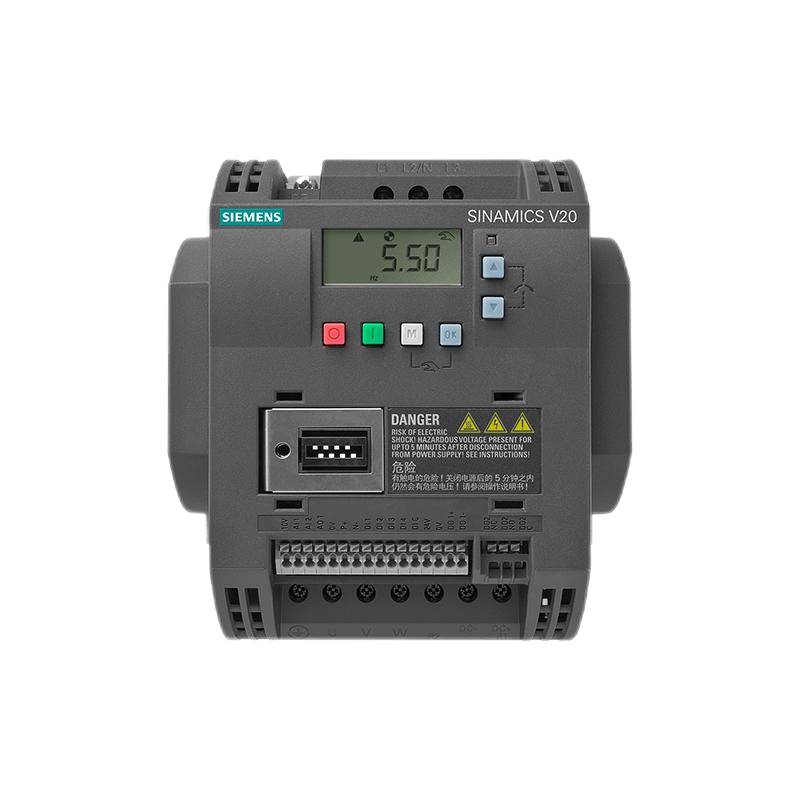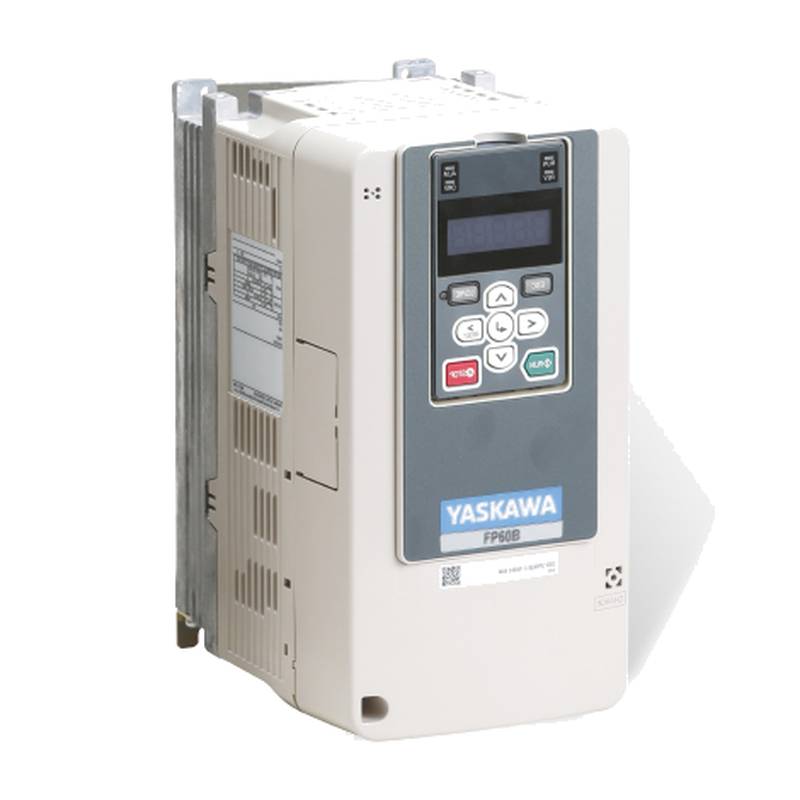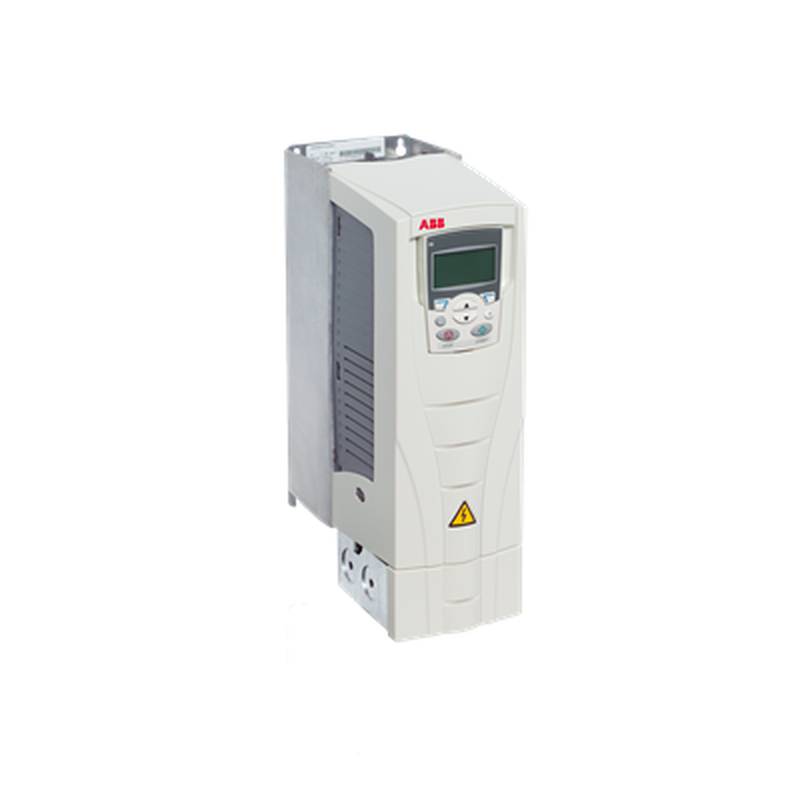
The Schneider Electric ATV630C16N4 is a high-performance variable frequency drive (VFD) designed for demanding industrial applications, offering precise motor control, enhanced energy efficiency, and robust protection. This 160kW, 284A, IP21-rated drive is engineered to optimize the performance of asynchronous and synchronous motors across a wide range of operating conditions. Its core advantages lie in its advanced features, including sophisticated motor control algorithms, integrated safety functions, and seamless connectivity, positioning it as a superior choice for complex machinery and process automation. The ATV630C16N4 boasts a nominal power of 160 kW, a rated current of 284 A, and an enclosure protection rating of IP21, ensuring reliable operation in challenging industrial environments.
Product Specifications
| Parameter | Value |
| :------------------------ | :------------------------- |
| Product Series | Altivar Process ATV600 |
| Drive Type | Variable Frequency Drive |
| Model Number | ATV630C16N4 |
| Rated Power (kW) | 160 |
| Rated Current (A) | 284 |
| Voltage Rating (V) | 380-415 |
| Protection Class (IP) | IP21 |
| Motor Control Type | Sensorless Flux Vector, DTC |
| Number of Phases | 3 |
| Mounting Type | Wall-mount, Cabinet-mount |
| Operating Temperature (°C) | -15 to 50 |
Core Features & Market Positioning
The Schneider ATV630C16N4 distinguishes itself through its advanced motor control capabilities, primarily leveraging Altivar’s proprietary Direct Torque Control (DTC) technology. This feature provides exceptional dynamic performance, enabling precise speed and torque regulation without the need for motor encoders, which simplifies installation and reduces potential failure points. Its robust design and comprehensive protection features, including thermal overload and short-circuit protection, ensure extended drive and motor lifespan, minimizing downtime and maintenance costs. The drive's integrated harmonic mitigation features, such as built-in filters, contribute to a cleaner power grid, making it compliant with stringent environmental regulations and enhancing overall system reliability. This positions the ATV630C16N4 as a premium solution for industries prioritizing performance, efficiency, and operational continuity.
Key Application Scenarios
The Schneider ATV630C16N4 is exceptionally well-suited for a variety of demanding industrial applications where precise control and high torque are essential. It excels in pump and fan control, managing flow and pressure with remarkable efficiency, leading to significant energy savings in HVAC, water treatment, and oil and gas sectors. In material handling systems, such as conveyors and cranes, its dynamic torque response ensures smooth acceleration and deceleration, preventing load slippage and mechanical stress. The drive is also a robust choice for demanding processing equipment like extruders, mixers, and crushers, where consistent torque output under varying loads is critical for product quality and throughput. Its ability to operate reliably in harsh environments further expands its applicability to mining, cement, and chemical processing industries.
Practical System Integration Guidance
Integrating the Schneider ATV630C16N4 into existing or new systems is streamlined due to its versatile connectivity options and intuitive setup. For typical industrial wiring, ensure compliance with local electrical codes. Connect the incoming power supply to the L1, L2, and L3 terminals, and the motor to T1, T2, and T3. Utilize the ground terminal for safety grounding. The drive supports standard communication protocols like Modbus TCP/IP and EtherNet/IP, enabling seamless integration into SCADA and PLC systems for remote monitoring and control. Commissioning involves configuring motor parameters, such as nominal voltage, current, and speed, typically via the drive's intuitive interface or the SoMove software. Key parameters for pump and fan applications include setting acceleration/deceleration ramps, speed limits, and enabling energy-saving features.
Operation and Risk Mitigation
Safe and efficient operation of the Schneider ATV630C16N4 necessitates adherence to established safety protocols and an understanding of its diagnostic capabilities. Always ensure power is disconnected and locked out before performing any wiring or maintenance. The drive incorporates essential safety functions, including Safe Torque Off (STO), which prevents unexpected machine startup by safely disabling the motor's torque. Common troubleshooting involves checking for error codes displayed on the HMI. For instance, an "Overcurrent" fault (FC01) might indicate a motor issue, incorrect parameter settings, or excessive load, requiring a review of the motor and load conditions. Similarly, an "Overvoltage" fault (FC02) could suggest issues with the incoming power supply or regenerative braking. Familiarizing yourself with the drive's fault code table in the user manual is crucial for rapid issue resolution.
Scalability & Long-Term Value
The Schneider ATV630C16N4 is designed for long-term value and scalability within industrial automation ecosystems. Its modular design allows for the addition of optional communication cards, expanding compatibility with various industrial networks and facilitating future upgrades. The drive integrates seamlessly with Schneider Electric's EcoStruxure™ platform, enabling advanced diagnostics, predictive maintenance, and remote asset management through IIoT connectivity. This integration provides valuable insights into drive performance and energy consumption, allowing for proactive optimization and minimizing unexpected downtime. Compatibility with a wide range of asynchronous and synchronous motors ensures flexibility in motor selection and replacement, protecting investments in existing machinery.
Frequently Asked Questions (FAQs)
Q1: What is the primary advantage of the Schneider ATV630C16N4 drive?
The Schneider ATV630C16N4 excels with its Direct Torque Control (DTC) technology, offering superior motor performance and dynamic response. This advanced control method ensures precise speed and torque accuracy without requiring motor feedback devices like encoders, simplifying setup and enhancing reliability.
This drive significantly boosts energy efficiency by precisely matching motor speed to application demand, reducing energy consumption during partial load conditions. Its robust design and integrated protection features also extend the lifespan of both the drive and the connected motor.
The ATV630C16N4 provides built-in safety functions, including Safe Torque Off (STO), which is crucial for machine safety and compliance with industrial safety standards, further adding to its value proposition.
Q2: How do I connect a motor to the Schneider ATV630C16N4?
Connect the motor to the drive's output terminals, typically labeled T1, T2, and T3, using appropriately sized and rated shielded motor cable to minimize electrical noise. Ensure the cable length does not exceed the manufacturer's recommendations to avoid issues like reflected wave phenomena.
The incoming power supply connects to the drive's power input terminals (L1, L2, L3 for 3-phase). It is essential to verify the incoming voltage matches the drive's specifications (380-415V for this model) and that proper circuit protection, such as a breaker or fuse, is installed upstream.
Proper grounding is critical for safety and electromagnetic compatibility. Connect the drive's ground terminal to a reliable earth ground, and ensure the motor frame is also properly grounded. Always follow local electrical codes and safety regulations during installation.
Q3: What are common fault codes for the ATV630C16N4 and their solutions?
An "Overcurrent" fault (e.g., FC01) often indicates the motor is drawing too much current. This can be due to a motor issue, incorrect motor parameters programmed into the drive, or the load exceeding the drive's capacity. Review motor nameplate data against drive settings and inspect the motor for mechanical problems.
An "Overvoltage" fault (e.g., FC02) typically occurs during deceleration if the motor is generating voltage that exceeds the drive's DC bus voltage limit, especially with high inertia loads. Consider adding a braking resistor or adjusting deceleration ramp times if this fault persists during normal operation.
A "Motor Thermal" fault (e.g., FLT.tH) signifies that the drive's internal thermal model for the motor has detected overheating. Ensure the motor thermal protection parameters are correctly set in the drive and that the motor's cooling system is functioning adequately.
Q4: Can the ATV630C16N4 be integrated into a PLC system?
Yes, the Schneider ATV630C16N4 features robust communication capabilities for seamless PLC integration. It supports common industrial fieldbuses like Modbus TCP/IP and EtherNet/IP, allowing for data exchange and control commands.
You can use dedicated communication modules or the integrated ports to connect the drive to your PLC network. This enables remote monitoring of drive status, speed commands, and fault diagnostics, as well as PLC-based control of drive functions.
Configuration involves setting up the communication parameters on both the drive and the PLC, defining the data registers for exchange. Refer to the drive's communication manual and your PLC's programming software for detailed integration steps.
Q5: What is the IP rating of the ATV630C16N4 and what does it mean?
The ATV630C16N4 has an IP21 rating. The first digit, '2', indicates protection against solid objects larger than 12.5mm, such as a finger, preventing contact with hazardous parts.
The second digit, '1', signifies protection against vertically falling water droplets. This means the drive is protected against condensation and light water ingress.
While IP21 offers basic protection against dust and dripping water, it is not suitable for direct water jets or highly dusty environments. For more demanding conditions, higher IP-rated enclosures or drives may be necessary.
Q6: How does the ATV630C16N4 improve energy efficiency?
The drive precisely adjusts motor speed to match the actual load requirements of the application, rather than running at full speed constantly. This is particularly effective for centrifugal loads like pumps and fans.
By slowing down the motor when full power isn't needed, the ATV630C16N4 significantly reduces energy consumption. The energy savings can be substantial, leading to a lower operational cost and a quicker return on investment.
The drive also incorporates advanced energy-saving functions and can provide energy consumption feedback, allowing users to monitor and optimize their energy usage further.
Q7: What types of motors can be controlled by the ATV630C16N4?
The Schneider ATV630C16N4 is designed to control standard three-phase asynchronous (induction) motors with high performance. It is particularly well-suited for applications requiring precise torque and speed control.
It also supports the control of permanent magnet synchronous motors (PMSM) and other synchronous motor types, leveraging its advanced DTC (Direct Torque Control) algorithms. This broad motor compatibility enhances its versatility.
When configuring the drive, it is crucial to select the correct motor type and accurately input the motor's nameplate data. This ensures optimal performance, protection, and efficiency.
Q8: What is Direct Torque Control (DTC)?
Direct Torque Control (DTC) is an advanced motor control algorithm developed by Schneider Electric. It allows for precise control of motor torque and speed without the need for a motor-speed encoder.
DTC works by directly controlling the motor's stator flux and torque, enabling very fast dynamic response and high accuracy, even under rapidly changing load conditions. This leads to smoother operation and better process control.
The elimination of encoders simplifies installation, reduces potential points of failure, and lowers overall system cost, making DTC a significant advantage for many industrial applications.
Q9: What are the installation requirements for the ATV630C16N4?
The ATV630C16N4 requires adequate ventilation to prevent overheating. Ensure sufficient clearance around the drive as specified in the installation manual for proper airflow. It can be wall-mounted or cabinet-mounted.
Electrical installation must comply with local electrical codes and standards. This includes proper grounding, using appropriately sized conductors for power and motor connections, and installing upstream overcurrent protection.
If using a shielded motor cable, ensure it is properly terminated at both the drive and motor ends to maintain its shielding effectiveness and minimize electromagnetic interference (EMI).
Q10: How can I access advanced features and programming for the ATV630C16N4?
The drive features an intuitive graphical display (HMI) for basic configuration and monitoring. For more complex parameter adjustments and programming, Schneider Electric offers the SoMove software.
SoMove allows for full drive configuration, parameter backup and restore, firmware updates, and advanced diagnostics via a PC or mobile device. It significantly simplifies commissioning and troubleshooting.
Additionally, network connectivity options enable remote programming and monitoring through SCADA systems or the EcoStruxure™ platform, allowing for centralized control and data analysis across multiple drives.














